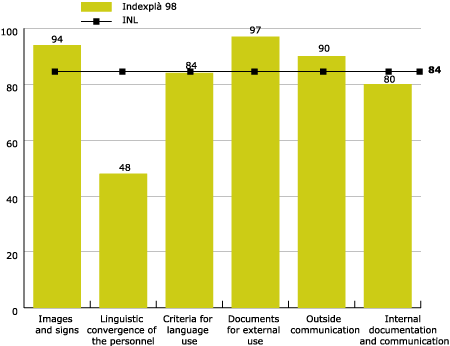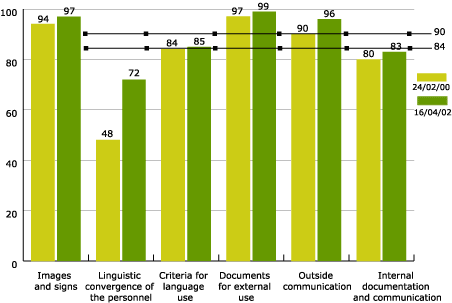
Summer 2003 |
| IndexplÓ. Programme for evaluation of organisations, by Alfred Castells | ||||
Summary 3. Utility of IndexplÓ in laguage planning 5. Appendices. Weighting of indicators in each factor 1. IndexplÓ. What is it? IndexplÓ is a computer programme that makes it possible to measure the extent of language normalisation, in terms of use of the Catalan language, using a system of indicators. The first version of the IndexplÓ programme, in use from 1995 to1998, was an application of Excel created by a team (1) at the Consortium for Language Normalisation (CPNL), a division of the Directorate General for Language Policy (DGPL) and a coordinator for computer matters. Once this version of IndexplÓ was in existence, in September 1995, its use was piloted in a dozen organisations in different ambits. This trial run made it possible to improve the tool before applying it in a widespread or general way. Extension of the application of IndexplÓ and the experience accumulated over the course of more than two years made it possible and indeed desirable to create a second, improved version, with contributions and suggestions from technical people who had been using it. Thus an enlarged working team (2) began working on this second version in 1998. Currently, a new team (3) is busy developing another version of IndexplÓ which will be a web application with a database that will collect historical information on the new corporation. The working methods will be much more rapid -based on questionnaires- and they will substantially increase opportunities for the exploitation of the data obtained. It is also planned to have a self-administering version on the Internet. 2.1 The indicators used are grouped according to six factors:
-each of which have a value or score of 0 to 100. A weighted mean is also obtained which has a value of between 0 and 100, and which gives the level or index of language normalisation (ILN) of an organisation as a whole. 2.2 This enables us to arrive at a graph which shows the level or index of linguistic normalisation (INL) of an organisation at a particular moment in time on a scale from 0 to 100. Knowing this level allows us to fix objectives and evaluate achievement, in accordance with the interests of the organisation. It is important to bear in mind that IndexplÓ is not a tool for obliging an organisation to take particular measures, but rather is there to serve the needs determined by the spokespeople of the organisations in question.
2.3 It is easy to apply because it simply puts into systematic form the information that is habitually obtained on a regular basis from an organisation. And it is, at the same time, practical because the indices are homogenous and allow immediate evaluation and comparison between different stages in the implementation of the same plan -progression- and between all organisations under study. 2.4 It is an instrument intended to be applied to any organisation of any type, from the simplest to the most complex, given that it is based on common variables with their equivalents in all organisations. What is more, the methodology and the language which is used are those typically used in connection with organisations (planning, management and evaluation). In any case, organisations have to have a minimum structure to make the use of IndexplÓ worthwhile. In this respect, very small associations, without premises of their own and with a limited output of written texts will need more help with "dynamisation" (revitalisation or boosting) rather than with planning. 2.5 It was decided to have one single version of IndexplÓ for all organisations and to increase flexibility when selecting elements to evaluate for each indicator. This is to make it is possible to obtain observations which reflect the degree of normalisation exactly, using the same parameters, whether we have to do with an organisation large or small, or with one territory or another. 2.6 Because of the large amount of information that the plan requires, it is applicable to organisations collaborated with on an ongoing or regular basis. It would not be worthwhile to use it with studies to determine the language normalisation index in a sample of organisations. It is, then, an instrument for the evaluation of results of a process of linguistic change, which makes it possible to evaluate very well the situation at the outset and after a course of action has been taken. 2.7 It is an instrument that makes it possible to evaluate all degrees of normalisation using a score from 0 to 100. It is useful, therefore, when applied to all language plan needs, since it can be adjusted to any of the objectives -partial, temporary or general- for any organisation. 2.8 It is extremely sensitive to change. It makes it possible to evaluate and quantify any progress made in linguistic normalisation in an organisation, however small it may be. A single page can show graphically the comparison between observations taken at different times.
2.9 The indicators are associated with a factor that they are affected by in particular. Despite that, they are also interrelated with other factors and they affect them to a secondary extent. It is for that reason that a change in value in a single indicator can have a detectable effect on a range. 2.10 The factors and indicators, as well as the scores and weightings have been analysed in depth so that the result, while arbitrary is the outcome of consensus. The attribute for each indicator has been analysed individually in relation to each of the factors and has been compared across all the indicators. 2.11 The weighting assigned to each factor in the ILN (weighted mean), which reflects the degree of language normalisation of the organisation has also been subject to consensus. These criteria, which have been modified for the second version are currently:
2.12 IndexplÓ makes it possible to set up typologies of organisations according to the degree of normalisation, and these typologies are more useful from the point of view of the internal dimension than the external:
3. Utility of IndexplÓ in language planning Language plans are instruments that the CPNL uses basically to provide the services that it offers to organisations, and which enable it to manage the latter's language needs. The language plans incorporate the aspirations of the organisation, determine objectives, actions to carry out and devise systems of evaluation. IndexplÓ has been applied to a large number of organisations of different sizes and types (private companies, hospitals, association, town halls, etc.) and territories with very different sociolinguistic situations. |

